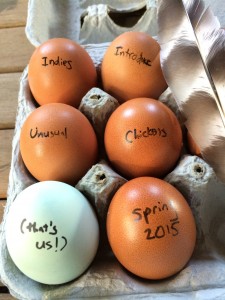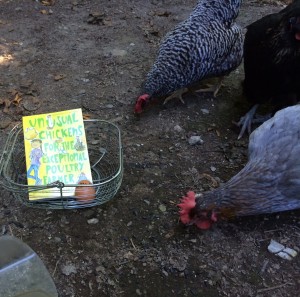 Thanks so much Lisa Doan for tagging me in the Writing Process Blog Tour!
Thanks so much Lisa Doan for tagging me in the Writing Process Blog Tour!
What am I currently working on?
I am wrapping up copy edits on my middle grade novel Unusual Chickens for the Exceptional Poultry Farmer, coming March 2015 from Knopf (and I can’t wait for you to read it!)
I’m also playing with a number of other ideas — everything from spies with magical disguises to goats, sauerkraut, and tap dancing. (Don’t ask me yet how that all fits together.) I wrote a normal chicken who’d had a spell cast on it for one test bit, but other than that, not a bawk bawk bawk!
How does my work differ from others of its genre?
Unusual Chickens has a taste of magical realism’s sense that magic is happening in a world we recognize, but it’s a dryer, funnier tone that’s a bit more straightforward than Guadalupe Garcia McCall’s Summer of the Mariposas, Louis Sachar’s Holes, or Jerry Spinelli’s Maniac Magee (all books I love!). It’s more about Sophie and her chickens and less about their part in the broader tapestry of history and their landscape.
Unusual Chickens differs from most middle grade fantasy because Sophie is half-Latina, half-white, lives on a farm in Northern California, and her struggles involve protecting chickens with superpowers, grieving for her grandmother, and making a place for herself in the small town she moves to, not dragons or wizards.
Why do I write what I write?
I’m always interested in seeing things differently, in what happens at the edges. When my first chickens came home, I couldn’t resist wondering what if… I adore books written in letters, so it didn’t surprise me when the chickens showed up in one. And as a former children’s librarian, it shocks and saddens me that there are still kids who rarely see themselves in fun and funny books and as heroes in stories with magic, so it was a great honor when Sophie showed up and shared her story with me. I’ve loved books with magic all my life, and I love adding to that picture in ways I haven’t seen before; my books always have at least a little magic.
How does my individual writing process work?
Oh, what a messy, inefficient process mine is! I usually start with a character who shows up, and with one or more interesting what ifs… I start researching anything I need to know a little more about (chickens, 4-H clubs, how superheroes describe superpowers, typewriters, poultry shows, what you would say to close a letter to your grandmother in Spanish) and then I follow the character around until I have a clear sense of who this person is, how they tell their story, and why they’re telling me all this.What does this person want, and why can’t they take care of it in a page or two? Around this time, I check in with my agent to see what she thinks, because the idea is much more malleable at this stage. If it can be tweaked into something that might be sellable, I keep working on it. If not right now, I set it aside for a while.
Once my agent is on board with an idea, I cobble together a skeleton book from all this with a lot of notes like [something goes here] and [fill this in later] and [why do chickens eat grit anyway?]. I usually write the beginning first, but after that I often write whatever scene interests me and sort out the order later. I use a writing program called Scrivener that makes this a little easier. (I’m not affiliated with Scrivener, it just works well for me.) Then I do more thinking and research, take a lot of long quiet walks, and write more scenes to make a draft or two, trying to fill in the gaps I can see with just enough detail to give you a sense of being there, and not so much you get bored. These early drafts don’t even look like a book, let alone the final book — they jump around and have huge holes and make little sense.
After that, I have to let it sit for a while, until I can see which words are on the page and which are still in my head somewhere. I start editing and filling more things in. I find the beginning goes fairly quickly, the middle is endless, and the end is also endless until suddenly it’s over. This part takes a long, long time, and all my writer friends know to sympathize and then tell me to keep working.
Then, I ask readers and writers to weigh in. If I am writing someone who is more like other writers than like me, I try to find at least a couple of other writers who have more in common with that character than I do, and see if they will help me fill in the gaps or correct the errors that they see. I don’t have a critique group, but I know a number of writers who are willing to swap drafts and give feedback. If I’m asking for help from someone, I suggest a trade — giving feedback takes a lot of time, and I like to be respectful of their writing time too. Often, I hear that I haven’t included enough detail on the page, so most of my edits tend to be filling in more gaps or correcting continuity issues that pop up when I move things around. And eventually it becomes a book, much to my surprise!
Tagged for next week:
Linda Johns
 Linda Johns is the author of Hannah West in the Belltown Towers and three other books in the Hannah West Mystery series (Penguin/Puffin), and close to 30 other books, primarily for the education and library market. She’s a librarian for Seattle Public Library (her day job). She’s currently working on a story set on the International Space Station.
Linda Johns is the author of Hannah West in the Belltown Towers and three other books in the Hannah West Mystery series (Penguin/Puffin), and close to 30 other books, primarily for the education and library market. She’s a librarian for Seattle Public Library (her day job). She’s currently working on a story set on the International Space Station.
Holly Bodger
 Holly Bodger is the author of 5 TO 1, coming from Knopf in May 2015.
Holly Bodger is the author of 5 TO 1, coming from Knopf in May 2015.
I’m looking forward to hearing about Linda and Holly‘s processes — check them out next week!
 UNUSUAL CHICKENS received a starred review from Kirkus!!!
UNUSUAL CHICKENS received a starred review from Kirkus!!! 











